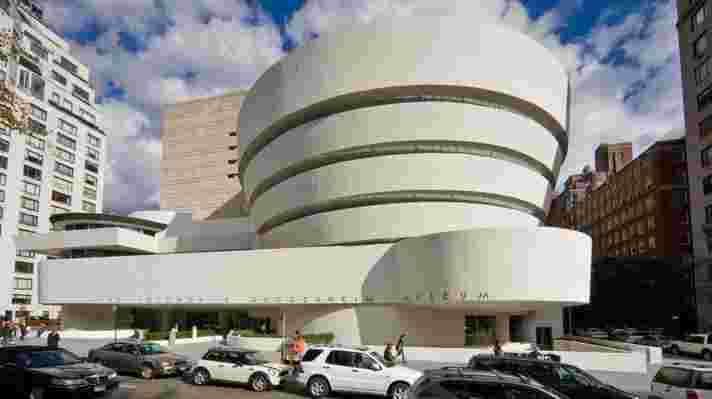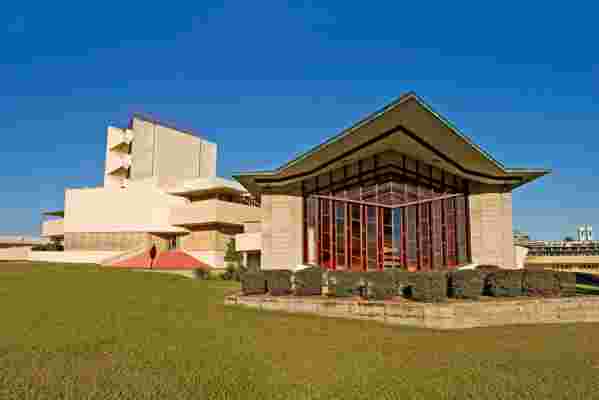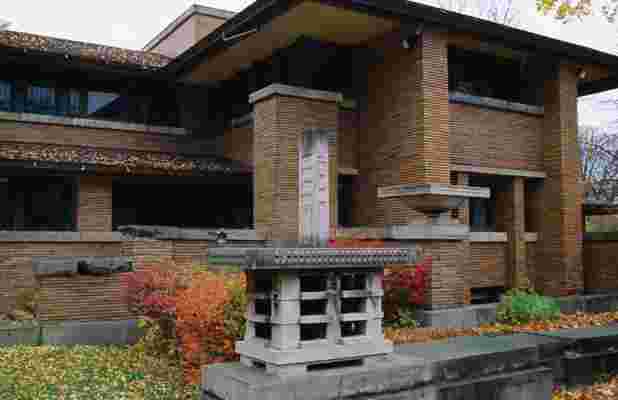12 East Coast Frank Lloyd Wright Buildings You Need to See
This June 8 marks the 150th anniversary of celebrated American architect Frank Lloyd Wright 's birth in 1867. His work revolutionized the American approach to living and function, as he steadily embraced change and experimented with new materials. Wright transformed the way in which we live through his innovative, sustainable design , and left his mark on hundreds of buildings around the country—532, to be exact—with hundreds more designed but never realized. Over the course of his seven-decade career, the architect was committed to democratic design, saying, "Above all, integrity, buildings, like people, must first be sincere, must be true." His philosophy is evident throughout his work: Wright designed environments that are both functional and elegant.
His work is inextricably linked to the Midwest, and for good reason: He worked there, he lived there, and much of his design philosophy was derived from the landscape of the country’s central region. While this may be true, to equate Wright with that one specific area would be to overlook the architect’s extensive—and equally remarkable—work on the coasts. Inspired by architectural historian Mark Wilson’s tome Frank Lloyd Wright on the West Coast , which makes a beautifully illustrated case for the importance of his buildings out west, AD decided to give a similar treatment to Wright’s work on the East Coast. Join us on a tour from New Hampshire to Florida to take a look at some of Wright’s most exquisite works this side of the Mississippi.

New York’s Guggenheim Museum.
Guggenheim, New York City
Completed just before Wright’s death in 1959, the Guggenheim Museum in Manhattan is perhaps the architect’s most famous building on the East Coast. With a nautilus shape towering over Central Park, the structure and its cavernous ramped interior marked a dramatic change in museum design around the world.
Auldbrass Plantation, Yemassee, South Carolina
The residential compound, which was built in 1940, features a swooping series of origami-like roofs that mimic its leafy southern surroundings. In the 1990s, it was painstakingly restored by movie producer Joel Silver, and its second life was featured in Architectural Digest.

A building at Florida Southern College.
Florida Southern College, Lakeland, Florida Containing the greatest concentration of the architect’s work in one locale, Florida Southern College is must-visit for any Wright fanatic. The ten buildings and two structures that make up Wright’s 1938 master campus design are known as “Child of the Sun,” a reference to the architect’s philosophy that the buildings were so intrinsically tied to their surroundings that they would appear to grow from the landscape.

The Darwin Martin House in Buffalo, New York.
Darwin D. Martin House, Buffalo, New York
Arguably the finest example of Wright’s Prairie Style on the East Coast, the Darwin D. Martin House was completed in 1905 and featured six distinct structures, though several have been damaged over time. Built for the Buffalo businessman and his family, the compound is a showcase for Wright’s signature planar lines and stained-glass windows.
The Pope-Leighey House in Virginia.
The Pope-Leighey House, Alexandria, Virginia
Originally situated in Falls Hill, Virginia, the Pope-Leighey House has been moved twice since its construction in 1940 and now stands on the grounds of Alexandria’s Woodlawn Plantation. Commissioned by journalist Loren Pope, who wrote to Wright requesting a building on a relatively small budget, the residence would come to define later Usonian homes, whose objective was often to satisfy the needs of a middle-class family.
Bachman-Wilson House, Crystal Bridges Museum, Bentonville, Arkansas
Though Wright built the 1956 Bachman-Wilson House in the quiet New Jersey suburb of Millstone, the home has since been moved to the campus of the Crystal Bridges Museum in Bentonville, Arkansas, after flooding in its original location. The house was built for a former Taliesin student of Wright’s and exemplifies the architect’s Usonian design philosophy.
The Dudley Spencer House.
Dudley Spencer House, Wilmington, Delaware
Another fine example of Usonian design, the Dudley Spencer House—or Laurel, as Wright liked to call it—was designed in 1956 to occupy a woodland lot in Wilmington, Delaware. Clad in fieldstone, the hemicycle-shaped structure features an open floor plan and abundant natural light.
Rayward-Shepherd House, New Canaan, Connecticut
Wright designed the Rayward-Shepherd House, another hemicycle design, in 1955 for Joyce and John Rayward. Construction was ultimately finished by the home’s second owner, Herman R. Shepherd. Wright referred to the house as Tirranna, an Australian aboriginal word for running water and a reference to the home’s unique waterscapes, inspired by the nearby Noroton River.
Zimmerman House, Manchester, New Hampshire
The only Wright residence in New England open to the public, the Zimmerman House is currently enjoying its second life as a part of New Hampshire’s Currier Museum of Art. Designed in 1950, the Manchester home’s original Wright-designed furnishings are still on display today alongside the owner’s art collection.
Crimson Beech house on Staten Island.
The Crimson Beech, Staten Island, New York
Also known as the Cass House for its original owners, Crimson Beech is a prefabricated issue from the architect’s Marshall Erdman Prefab Houses series. Erected in 1959, the single-story house, whose name is derived from its red brick exterior, is Wright’s only residential work in New York City.
Theodore Baird Residence, Amherst, Massachusetts
Wright’s only building in Massachusetts, the Theodore Baird House is a fine Usonian example that was built for Amherst College professor Theodore Baird in 1940. The horizontal structure is dotted throughout with floor-to-ceiling windows that connect its open floor plan with the surrounding landscape.
Massaro House, Lake Mahopac, New York Wright drew up plans for this island residence in 1949, but the property was left unbuilt until Joseph Massaro discovered and constructed the architect’s design in 2002. Since then, the home has received its fair share of controversy, as the Frank Lloyd Wright Foundation does not consider it to be an authentic Frank Lloyd Wright creation.